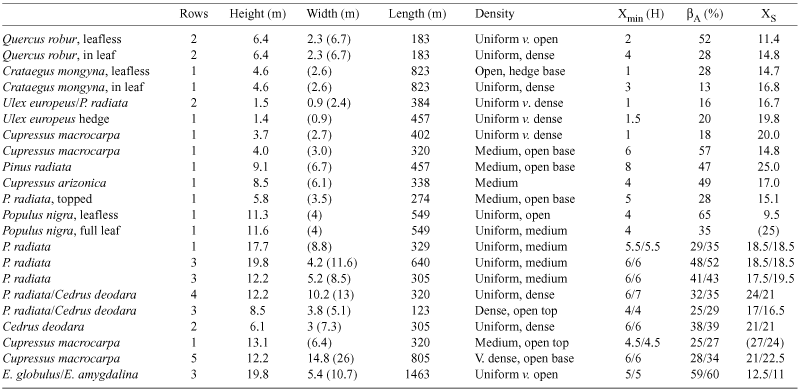Effects of windbreak structure on shelter characteristics
P. R. Bird A C , T. T. Jackson A , G. A. Kearney A and A. Roache BA Department of Primary Industries, Private Bag 105, Hamilton, Vic. 3300, Australia.
B ‘Glenwood’, Hawkesdale, Vic. 3287, Australia.
C Corresponding author. Email: rod.bird@dpi.vic.gov.au
Australian Journal of Experimental Agriculture 47(6) 727-737 https://doi.org/10.1071/EA06086
Submitted: 24 March 2006 Accepted: 18 October 2006 Published: 17 May 2007
Abstract
Eleven windbreaks (Monterey cypress, Monterey pine, tuart, sugar gum, black wattle and mixed native species) were studied in south-west Victoria. Windrun (U) was measured with cup anemometers set above ground (Z) at 1.5 m and 0.5 m (eight windbreaks), 1.5 m (two windbreaks), or 0.5 and 0.25 m (0.95 m mesh). The U pattern (U/U0, where U0 is open windspeed) was: (1) to windward, a shelter effect to at least –3 H, (where H means windbreak height) with a reduction of 20% or more at –1 H and (2) to lee, Xmin (position of minimum windspeed, Umin) from 1–7 H; Umin (minimum U/Uo) varied with windbreak density; and XS (distance where U/U0 is <0.8) varied from 8–25 H. Optical porosity (βO) was 0.16–0.53 compared with 0.24–0.61 for aerodynamic porosity (βA), obtained from the ratio of Umin and U0. βA from present data and calculated for windbreaks of previous studies, showed a curvilinear effect of windbreak porosity (βA, %) on Xmin, but little effect on XS: Xmin (H) = 3.008LnβA – 6.6 (adjusted r2 = 0.33, P < 0.0001, r.s.d. = 1.8); XS (H) = 12.2+ 0.307βA – 0.0047βA2 (adjusted r2 = 0.07, P < 0.08, r.s.d. = 4.1). Effective shelter is best obtained by establishing tall, dense windbreaks and excluding browsing livestock.
Acknowledgements
We acknowledge the following landholders who gave us access to their shelterbelts: G. Hermann, ‘Kanandah’, Cartys Rd, Hamilton; G. Roache, ‘Glenwood’, Hawkesdale; J. Gubbins, ‘Coolana’, Chatsworth; P. Waldron, ‘Willandra’, Melville Forest; R. Jamieson, ‘Bolac Plains’, Woorndoo; R. Dawson, ‘Kooringal’, Hawkesdale; B. Milne, ‘Helm View’, Melville Forest. We also acknowledge the assistance of Kay Aldridge, John Cayley, Keith Cumming and Glenys Downes for technical assistance at various stages of this work. Anne Roache collected data from the Hawkesdale shelterbelts as part of a degree of Bachelor of Agricultural Science with La Trobe University.
Bean A,
Alperi RW, Federer CA
(1974) A method for categorizing shelterbelt porosity. Agricultural Meteorology 14, 417–429.
| Crossref | GoogleScholarGoogle Scholar |

Bird PR
(1986) Trees in Western Victoria – an historical perspective. Trees and Victoria's Resources 28, 9–11.

Bird PR
(1998) Tree windbreaks and shelter benefits to pastures in temperate grazing systems. Agroforestry Systems 41, 35–54.
| Crossref | GoogleScholarGoogle Scholar |

Bird PR, Cayley J
(1991) Bad weather, shelter and stock losses. Agricultural Science 4, 18–19.

Bird PR,
Lynch JJ, Obst JM
(1984) Effect of shelter on plant and animal production. Proceedings of the Australian Society of Animal Production 15, 270–273.

Bird PR,
Bicknell D,
Bulman PA,
Burke SJA,
Leys JF,
Parker JN,
van der Sommen FJ, Voller P
(1992) The role of shelter in Australia for protecting soils, plants and livestock. Agroforestry Systems 20, 59–86.
| Crossref | GoogleScholarGoogle Scholar |

Cleugh HA
(1998) Effects of windbreaks on airflow, microclimates and crop yields. Agroforestry Systems 41, 55–84.
| Crossref | GoogleScholarGoogle Scholar |

Cleugh HA
(2002) Field measurements of windbreak effects on airflow, turbulent exchanges and microclimates. Australian Journal of Experimental Agriculture 42, 665–677.
| Crossref | GoogleScholarGoogle Scholar |

Cleugh HA, Hughes DE
(2002) Impact of shelter on crop microclimates: a synthesis of results from wind tunnel and field experiments. Australian Journal of Experimental Agriculture 42, 679–701.
| Crossref | GoogleScholarGoogle Scholar |

Cleugh HA,
Miller JM, Bohm M
(1998) Direct mechanical effects of wind on crops. Agroforestry Systems 41, 85–112.
| Crossref |

George EJ,
Broberg D, Worthington EL
(1963) Influence of various types of field windbreaks on reducing wind velocities and depositing snow. Journal of Forestry 61, 345–349.

Heisler GM, deWalle DR
(1988) Effects of windbreak structure on wind flow. Agriculture Ecosystems & Environment 22–23, 41–69.
| Crossref | GoogleScholarGoogle Scholar |

Judd MJ,
Raupach MR, Finnigan JJ
(1996) A wind tunnel study of turbulent flow around single and multiple windbreaks. Boundary-Layer Meteorology 80, 127–165.
| Crossref | GoogleScholarGoogle Scholar |

Kaiser H
(1959) Die Strömung an Windschutzstreifen. Bereich des Deutschen Wetterdienstes Bad Kissingen 7, 1–36.

Kort J
(1988) Benefits of windbreaks to field and forage crops. Agriculture Ecosystems & Environment 22–23, 165–190.
| Crossref | GoogleScholarGoogle Scholar |

Marshall JK
(1967) The effect of shelter on the productivity of grasslands and field crops. Field Crop Abstracts 20, 1–14.

Nägeli W
(1943) Untersuchungen über die Windverhältnisse im Bereich von Windschutzstreifen. Mitteilungen für die Schweizerische Anstalt für das forstliche Versuchswesen 23, 223–276.

Nägeli W
(1946) Weitere Untersuchungen über die Windverhältnisse im Bereich von Windschutzstreifen. Mitteilungen für die Schweizerische Anstalt für das forstliche Versuchswesen 24, 660–737.

Nuberg IK
(1998) Effect of shelter on temperate crops: a review to define research for Australian conditions. Agroforestry Systems 41, 3–34.
| Crossref | GoogleScholarGoogle Scholar |

Sturrock JW
(1969) Aerodynamic studies of shelterbelts in New Zealand -1. Low to medium height shelterbelts in mid Canterbury. New Zealand Journal of Science 12, 754–776.

Sturrock JW
(1972) Aerodynamic studies of shelterbelts in New Zealand -2. Medium height to tall shelterbelts in mid Canterbury. New Zealand Journal of Science 15, 113–140.

Wang H, Takle ES
(1995) A numerical simulation of boundary layer flows near shelterbelts. Boundary-Layer Meteorology 75, 141–173.
| Crossref | GoogleScholarGoogle Scholar |

Wang H, Takle ES
(1996) On shelter efficiency of shelterbelts in oblique wind. Agricultural and Forestry Meteorology 81, 95–117.
| Crossref | GoogleScholarGoogle Scholar |


|

|

|


